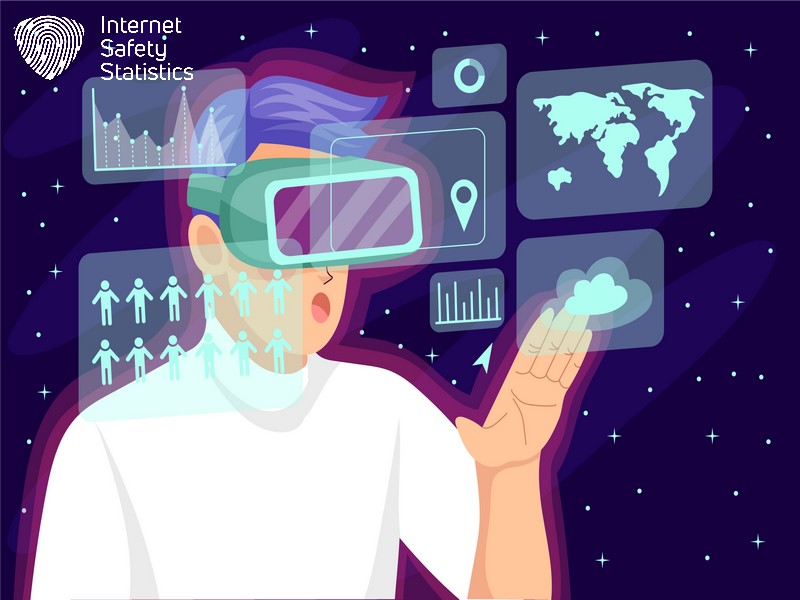
Virtual Reality (VR) rapidly transforms entertainment, education, and even professional applications. However, as we delve deeper into these immersive digital worlds, a critical question arises: how will VR impact cybersecurity? While some envision VR as a training tool for cybersecurity professionals, the potential threats lurking within these virtual spaces cannot be ignored.
VR experiences often involve collecting and transmitting user data, including biometrics, movement patterns, and emotional responses. This raises concerns about data privacy and potential information storage and access vulnerabilities. Additionally, the highly immersive nature of VR raises questions about user manipulation and the possibility of malicious actors exploiting VR environments for phishing attacks or social engineering scams.
This analysis explores the evolving relationship between virtual reality and cybersecurity. We will delve into the potential security risks of VR technology, including data privacy concerns and possible manipulation within virtual environments. The discussion will then shift towards strategies for mitigating these risks and fostering a secure VR experience for all users. Acknowledging and addressing these challenges can pave the way for a future where VR thrives alongside robust cybersecurity measures.
Dive in for vital safety tips!
Understanding Virtual Reality
Virtual Reality (VR) is a computer-generated simulation of an environment that can be interacted with in a seemingly real or physical way. VR technology has various applications, including gaming, entertainment, education, and training.
Definition and Explanation
Virtual reality, often called VR, immerses users in a completely digital environment using headsets and motion-tracking technology. This simulated world responds to user interactions, creating an experience that mimics real life or conjures up fantastical settings. It combines complex software and hardware to trick the brain into believing it’s entirely somewhere else.
Cybersecurity enters the picture when considering how these immersive experiences connect to our lives online. With researchers uncovering vulnerabilities in popular VR equipment, like headsets with motion sensors that could expose users’ private speech and actions, securing these virtual spaces becomes crucial.
As we adopt VR for entertainment, education, and professional training, ensuring these environments are safe from cyber threats is essential to protecting personal data and maintaining privacy within the metaverse.
Applications of VR
While VR poses potential security challenges, its applications extend far beyond entertainment. VR training programs are revolutionising fields like healthcare and engineering, while virtual environments hold immense potential for education, communication, and even physical rehabilitation.
- Training and Education: VR can simulate real-life scenarios for cybersecurity training, allowing professionals to practise identifying potential threats in a realistic environment.
- Data Visualisation: Virtual reality can visualise complex data sets and network structures, providing a better understanding of cyber threats and defences.
- Remote Collaboration: VR enables remote teams to collaborate in virtual environments, enhancing communication and problem-solving for cybersecurity tasks.
- Security Testing: Virtual reality can create simulated cyber attack scenarios to test the resilience of security measures and response protocols.
- Risk Assessment: VR simulations can provide a platform for assessing potential vulnerabilities and risks within digital environments, aiding in proactive threat mitigation.
Impact of Emerging Virtual Reality Trends on Cybersecurity
The increased reliance on virtual reality technology has opened new avenues for cyber threats and attacks. As VR becomes more integrated into daily life, it’s crucial to understand the potential cybersecurity risks that come with it.
Increased Reliance on Technology
Increased reliance on technology has led to an exponential rise in virtual reality (VR) and augmented reality (AR) applications, creating innovative opportunities and introducing new cybersecurity challenges.
As more individuals and businesses embrace VR and AR for training, entertainment, and communication, the potential for security vulnerabilities grows. Integrating immersive technologies with everyday activities opens up avenues for threat actors to exploit weaknesses in these systems, posing a risk to data privacy and network security across various industries.
As we continue to depend on advanced technologies like VR and AR, it becomes crucial for users to stay informed about the evolving cyber threats associated with these platforms.
Virtual Threats and Attacks
Virtual threats and attacks in virtual reality (VR) environments evolve as technology advances. Cybercriminals can exploit security vulnerabilities in VR headsets, potentially recording sensitive information such as speech and movements.
This poses a significant risk to individuals and organisations using VR technology. Additionally, immersive technologies like VR for training cybersecurity professionals offer threat actors opportunities to gain practical experience in detecting and responding to cyber-attacks.
It’s crucial for users to stay informed about potential security risks associated with VR and augmented reality (AR) technologies and to be proactive in implementing robust cybersecurity measures.
Utilising Immersive Technology for Cybersecurity Training

Immersive technology like AR and VR have become valuable tools in cybersecurity training for individuals and organisations. They provide hands-on experience and realistic simulations to enhance cyber situational awareness.
AR and VR in Training
Immersive technology like augmented reality (AR) and virtual reality (VR) are revolutionising cybersecurity training, providing realistic simulations of cyber threats and attacks. This enables individuals and organisations to gain practical experience in identifying and responding to cybersecurity challenges. Here are ways AR and VR are being utilised for cybersecurity training:
- Simulating real-world cyber attacks: AR and VR technologies allow cybersecurity professionals to practise identifying and responding to various cyber threats in simulated environments, enhancing their threat detection capabilities.
- Interactive training scenarios: Users can engage in interactive scenarios where they encounter simulated cyber threats, learning to handle potential breaches effectively.
- Hands-on experience with security measures: Individuals can use AR and VR to familiarise themselves with different security protocols and learn how to implement them practically, enhancing their cyber defence skills.
- Collaborative training exercises: AR and VR enable individuals to participate in collaborative exercises to work together to address cybersecurity challenges within a virtual environment.
- Adaptable training environments: These technologies offer the flexibility to create customised training environments that mirror specific real-world cyber threats, providing tailored learning experiences for different industry sectors.
- Practical application of theoretical knowledge: Users can apply theoretical concepts learned in traditional cybersecurity training programs to hands-on simulations in AR and VR, reinforcing their understanding of best practices in cyber defence.
- Real-time feedback and assessment: AR and VR can provide immediate feedback on users’ responses to cyber threats, allowing for continuous improvement and skill development.
- Enhanced engagement through gamification: By integrating gamification elements into training modules, AR and VR make cybersecurity learning more engaging and enjoyable for participants.
Benefits for Individuals and Organisations
VR offers a treasure trove of benefits for both individuals and organizations. VR can enhance learning and skills development for individuals, while organisations can leverage VR for employee training, remote collaboration, and product design.
- AR and VR technology provides immersive and realistic training experiences for individuals and organisations.
- Through virtual simulations, professionals can gain hands-on experience identifying and responding to cyber threats.
- VR technology offers a safe environment for cybersecurity training, allowing individuals to practise without risking actual systems or data.
- This training enhances situational awareness, equipping individuals with the knowledge and skills to effectively combat cyber threats.
- Organisations can use VR technology to streamline their cybersecurity training programmes, reducing costs associated with traditional training methods.
Addressing Unique Cybersecurity Challenges in VR and AR Environments
VR sickness, or virtual reality motion sickness, can impact individuals using VR and AR environments, leading to potential vulnerabilities in their cybersecurity awareness and response. Securing virtual environments presents unique challenges, as traditional security measures may not be applicable in immersive digital spaces.
VR Sickness and Its Impact
VR sickness, also known as cybersickness or simulator sickness, encompasses symptoms such as nausea, headache, and disorientation experienced by some individuals when using virtual reality technology. This can significantly impact users’ overall experience with VR applications and limit the widespread adoption of this immersive technology. Researchers have identified factors such as visual-vestibular conflicts and individual susceptibility contributing to VR sickness.
Understanding these factors is crucial for designing VR experiences that minimise these adverse effects.
Securing Virtual Environments
Securing virtual environments is crucial to protect sensitive data and prevent unauthorised access. Virtual reality (VR) technology introduces unique cybersecurity challenges, such as potential security vulnerabilities in VR headsets that hackers could exploit to record users’ subtle movements and speech, posing a risk to privacy and data security. Additionally, using immersive technologies like VR for cybersecurity training brings benefits but also requires robust measures to safeguard against exploitation by threat actors.
With the emergence of metaverse platforms combining VR and augmented reality (AR), innovative security threats arise, highlighting the need for continuous vigilance in securing virtual environments. Efforts towards securing virtual environments involve addressing ethical and legal concerns surrounding user privacy and data collection in VR experiences. Moreover, understanding the distinct nature of VR security threats compared to AR is essential as it allows for targeted measures based on unique vulnerabilities in closed virtual environments.
Future of Virtual Reality and Cybersecurity

The future of virtual reality and cybersecurity holds potential for growth and advancements, with the need to stay ahead of emerging threats becoming increasingly important. As VR and AR technologies evolve, it’s crucial to anticipate and address new types of cyber threats to maintain online safety.
Potential Growth and Advancements
Virtual reality (VR) and augmented reality (AR) technologies are poised for significant growth and advancements, offering exciting opportunities and raising new cybersecurity challenges. As VR and AR become more integrated into daily life, cyber threats in virtual environments are expected to evolve. Individuals and organisations must stay proactive in addressing these emerging threats by embracing innovative security measures tailored specifically for immersive technology.
Researchers have identified potential vulnerabilities in popular VR headsets, highlighting the need for robust security protocols to safeguard against possible breaches. Moreover, as the metaverse expands, the interconnected nature of virtual interactions creates novel avenues for cybercrime.
Importance of Staying Ahead of Threats
Staying ahead of cyber threats is crucial in our rapidly evolving digital landscape. With the emergence of virtual reality and augmented reality, new types of security risks are becoming prevalent. Individuals and organisations can better protect themselves from potential breaches and attacks by keeping abreast of these threats. Understanding VR technology’s unique challenges, such as securing virtual environments and addressing VR sickness’s impact on users, is essential for maintaining robust cybersecurity measures.
Moreover, ongoing vigilance and proactive strategies are necessary to anticipate and mitigate novel cyber threats that may arise within immersive technologies like virtual reality. Staying ahead of cyber threats also involves preparing for potential ethical and legal issues related to privacy concerns and data collection in virtual reality environments.
Cybersecurity must adapt to address new threats as virtual reality continues to evolve. Professionals and organisations need to embrace immersive technology for training while also being vigilant about potential vulnerabilities. The future of virtual reality and cybersecurity will require staying ahead of emerging risks and continually improving defences against cyber threats. Immersive experiences offer both opportunities and challenges in the realms of privacy, security, and ethical considerations.
It is crucial to remain proactive in harnessing the benefits of virtual reality while safeguarding against its associated risks.
FAQs
What new cyber threats come with virtual reality?
Emerging trends in virtual reality bring unique cyber threats, such as phishing attacks within the metaverse and vulnerabilities in augmented reality (AR) systems.
How does cybersecurity relate to education?
Cybersecurity is crucial for K-12 schools that use information technology, as they must guard against cyber threats that can disrupt digital security and learning.
Can the metaverse impact cybersecurity?
Yes, with the rise of virtual reality, the metaverse introduces complex challenges for cybersecurity professionals who must now prepare to protect users from innovative online risks.
Are there cybersecurity measures for AR and VR technologies?
Indeed, keeping up with evolving digital security measures is essential for safeguarding augmented reality applications and effectively defending against virtual reality cyber threats.
